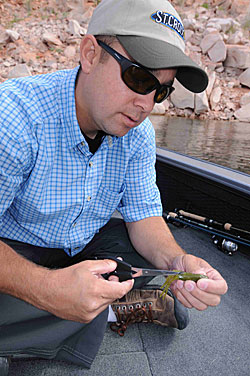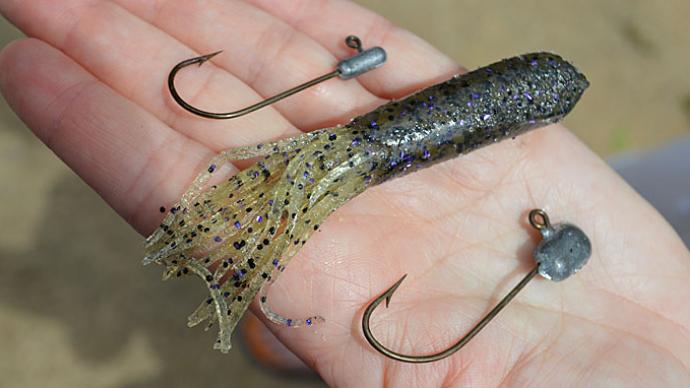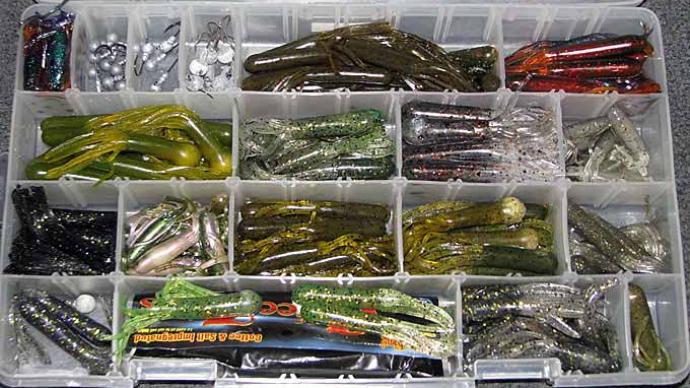
Other soft plastics have more fancy frills and flashy appendages, but the plain old tube bait consistently draws more strikes from bass with less pizzazz.
“A tube is unique because it has a hollow belly, so it is never going to fall the same way twice in the water column depending on how you rig it,” says Jarrett Edwards, the host of “Jarrett Edwards Outdoors,” a national TV show. “The 3 1/2-inch tube in crawdad colors dragged and hopped along the bottom imitates a crawdad better than anything else. So obviously, with a crawdad being a part of the bass’ diet, I think that is very important.”
A tube bait particularly shines for Edwards whenever the water temperature exceeds 50 degrees. “I have found the tube is a phenomenal bait beginning in spring into fall,” he says. “When the water is below 52 to 53 degrees, I will go to a standard jig versus the tube.”
The former Bassmaster Elite Series pro also believes the tube outperforms other soft plastics in clear water on sunny, calm days. “The tube is an underrated bait when conditions are slick,” he says. “It is a do-nothing, subtle bait, and when you pair it with the right colors on bluebird days, it is an unobtrusive approach to get the fish to bite.”
A Big Bite Baits Tube is Edwards’ choice for catching both smallmouth and largemouth when he has to resort to finesse tactics in clear to stained water. “I look for the tube with the thinnest wall possible,” says Edwards. “In the ultra-clear water that we have out West, it presents a lighter bait; therefore, when I put on a 1/8- or 1/4-ounce jighead, I know I am getting pretty close to the right weight/fall ratio, and that is important to me.”
The former Lake Powell guide prefers tubes in natural colors such as pumpkinseed or green pumpkin when he wants to drag the lure along the bottom to imitate a crawfish. He opts for smoke or transparent hues for suspended bass to imitate a baitfish. Edwards favors a black/red flake tube for fishing in stained to murky water.
One modification Edwards makes to trick finicky fish in clear water is to pull every other tentacle out of the tube to create a smaller profile bait. “What that does is it breaks up the tube to be about 2 3/4 of an inch,” he says.
Rigging the tube depends on how Edwards wants to present the bait. “If I am trying to throw to an object in the water like right next to a dock, a tree, or more importantly a bedding bass in 6 to 8 feet of water, I want to use a ball jighead,” he says.

“I want to keep it outside (of the bait) and thread on the tube like I would a shaky head.” He believes rigging the head on the outside allows the right amount of air to exit the tube body when it hits the water, creating more of a vertical drop with less spiral. He prefers a 1/8- or 1/4-ounce jighead for most of his applications, although he will occasionally switch to a 3/8- or 1/2-ounce model if he wants a fast fall.
When he wants a tube to spiral and have more hang time to trigger strikes from suspending bass, Edwards selects a Bite Me Tackle Flat Eye Tube Jig, which features a teardrop weight that can easily be inserted into the tube’s hollow body. He favors a 1/8-ounce jighead to allow the tube to slowly fall and spiral in front of bass suspended under docks or in standing timber.
Two basic retrieves (dragging and hopping) work best for Edwards’ tube tactics. He begins his dragging presentation by casting out the tube and letting it fall until his line goes slack, which indicates the lure is on the bottom “I put the rod tip down to the 6 or 7 o’clock position and with the spinning reel I just tighten up my line and slowly reel and watch the tip of my rod,” says Edwards, who works the tube on a 7-foot medium-light St Croix Legend Elite rod and a 2500 series spinning reel spooled with 4- to 6-pound fluorocarbon line.
“Most people fish a tube like a jig,” Edwards says. “They throw it out and lift their rod and drop it. They don’t realize that when they lift a 7-foot rod, their bait moves double the distance (10 to 14 feet) in the water.” Edwards suggests this causes them to move the lure too much and fish it too fast.
The Arizona angler believes keeping his rod in the same position and moving the lure strictly with his reel gives him better sensitivity to feel transitions in the bottom contour and detect strikes. The lower rod angle helps him keep his line tight and puts his rod in position for a solid hookset. “So by leaving the rod tip in one place and just using my reel to move that bait along the bottom, I force myself to fish slow, I find what type of structure those fish are on, and I don’t deep hook tube fish because when they bite I am on them right away,” he says.
When he wants to hop a tube, Edwards keeps his rod at the 9 o’clock position and again uses his reel to move the bait. He quickly jerks on the reel handle to create a hopping motion with the tube. Edwards prefers this presentation when he wants to cover more water with his tube bait.
While the tube has produced catches of 50 fish in a day for Edwards at Lake Powell, he has also done well on the finesse lure at other locations during his time on the tournament trail. “I love Missouri lakes (for tube fishing),” he says. “I have caught fish well on a tube at Table Rock and Lake of the Ozarks. The tube is a phenomenal underrated bait for spotted bass fisheries across the country. Spots love tubes, no doubt about it.”
BassResource may receive a portion of revenues if you make a purchase using a link above.




